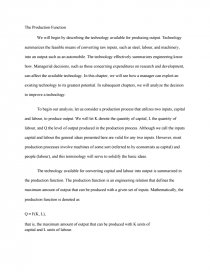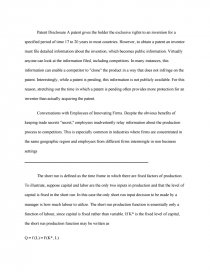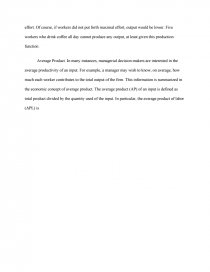The Production Function
Essay by mizzreina • November 30, 2013 • Essay • 1,352 Words (6 Pages) • 1,675 Views
The Production Function
We will begin by describing the technology available for producing output. Technology summarizes the feasible means of converting raw inputs, such as steel, labour, and machinery, into an output such as an automobile. The technology effectively summarizes engineering know how. Managerial decisions, such as those concerning expenditures on research and development, can affect the available technology. In this chapter, we will see how a manager can exploit an existing technology to its greatest potential. In subsequent chapters, we will analyze the decision to improve a technology.
To begin our analysis, let us consider a production process that utilizes two inputs, capital and labour, to produce output. We will let K denote the quantity of capital, L the quantity of labour, and Q the level of output produced in the production process. Although we call the inputs capital and labour the general ideas presented here are valid for any two inputs. However, most production processes involve machines of some sort (referred to by economists as capital) and people (labour), and this terminology will serve to solidify the basic ideas.
The technology available for converting capital and labour into output is summarized in the production function. The production function is an engineering relation that defines the maximum amount of output that can be produced with a given set of inputs. Mathematically, the production function is denoted as
Q = F(K, L),
that is, the maximum amount of output that can be produced with K units of
capital and L units of labour.
Short Run Versus Long Run Decisions
As a manager, your job is to use the available production function efficiently; this effectively means that you must determine how much of each input to use
to produce output. In the short run, some factors of production are fixed, and this limits your choices in making input decisions. For example, it takes several years for Ford to build an assembly line. The level of capital is gener¬ally fixed in the short run. However, in the short run Ford can adjust its use of inputs such as labour and steel; such inputs are called variable factors of production.
__________________________________________________________
Inside Business 5 1
Where Does Technology Come From?
In this chapter, we simply assume that the manager knows the underlying technology available for producing goods. How do managers acquire information about technology? The answer varies considerably across firms. The accompanying table reports the results of a survey of 650 executives in 130 industries. They were asked to rate how they obtain technical knowledge of new technologies developed by competitors. The responses varied considerably among executives, and there were also systematic differences in responses depending on whether the technical knowledge pertained to a process innovation or a product innovation. A process innovation is simply a new method for producing a given good, while a product innovation is the creation of a new product.
Independent R&D. As the accompanying table shows, the most important means of acquiring product and process innovations is independent research and development (R&D). This essentially involves engineers employed by the firm to devise new production processes or products. Most large firms have a research and development department that is charged with engineering aspects of product and process innovations.
Licensing Technology. The firm that was originally responsible for developing the technology and thus owns the rights to the technology often sells the production function to another firm for a licensing fee. The fee may he fixed, in which case the cost of acquiring the technology is a fixed cost of production. The fee may involve payments based on how much output is produced. In this instance, the cost of the technology is a variable cost of production.
Publications or Technical Meetings. Trade publications and meetings provide a forum for the dissemination of information about production processes.
Methods of Acquiring Technology (Ranked from Most Important to Least Important)
Reverse
...
...





